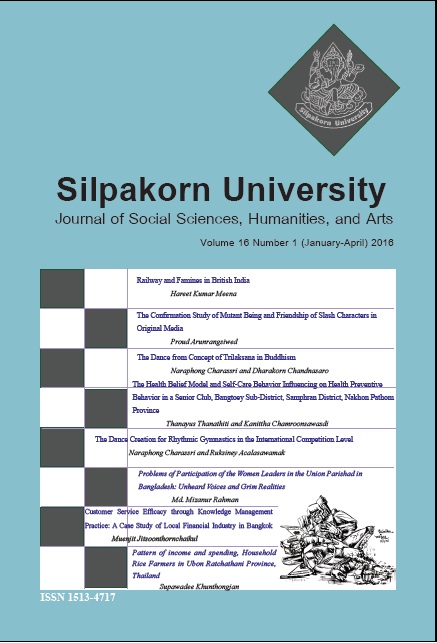The Dance from Concept of Trilaksana in Buddhism
Main Article Content
Abstract
The objectives of this dissertation are to create dance pattern and to explore dance creation concept. This research has been regards as creative research and qualitative research approaches. Research context includes multidisciplinary studies from the Concepts of Buddhism, Philosophy, Dance, and Fine and Applied Arts. Research tools include standard criteria of artists, analysis from documents and textbooks, electronic media that are related to dance, and in-depth interviews with specialists. Data will be analyzed, synthesized, supported dance, and summarized respectively. Findings shown that pattern of dance can be divided into 8 elements which are (1) The Script created based on concept of Trilaksana in Buddhism (2) The Performers with competency in dance, emotional expression and message communication (3) The Choreography of postmodern dance concept (4) The Music design from instruments that create ambience of meditation (5) The Props and performance crafts design in minimalism concept that symbolize simple and cost-saving view which is easy to convey message; lotus and candle (6) The Performance area that ignores traditional stage in theatre and rather use open areas (7) The Lighting design that applies color theory in conveying story, feelings and events and (8) The Costumes design with minimalism concept that ignore gender but focus on unity. Dance creation concept focuses on 7 aspects which are (1) Philosophy of Buddhism (2) Simplicity based on postmodern dance (3) Creativity in dance (4) Symbols in dance (5) Theories of dance, music, and visual arts (6) Social reflection through dance and 7) Creative dance for children. Researcher has arranged dance exhibition to gain public feedback. Audiences include 249 dance secondary-level students, undergraduates, specialists, dance artists, dance teachers in university and secondary school, and public. Findings from public criticism and questionnaires had shown that application of Trilaksana in Buddhism concept as a part of dance is unique and challenging for both exhibitors and audiences. This is the creative art that blends both oriental and western cultures and gain significant public acceptance. Audiences also perceived that this creative dance is the knowledge worth sharing to all Buddhists.
Downloads
Article Details
All rights reserved. Apart from citations for the purposes of research, private study, or criticism and review,no part of this publication may be reproduced, stored or transmitted in any other form without prior written permission by the publisher.
References
Burawas, S. (2011) 25th Century of Buddhishic Philosophy (“พุทธปรัชญา 25 ศตวรรษ”). Bangkok: Siam.
Charassri, N. (2005) History of Western Dance (“ประวัตินาฏยศิลป์ตะวันตก”). Bangkok: Chulalongkorn University Press.
Lihs, H. (2009) Appreciating Dance: A Guide to the World’s Liveliest Art. Canada: Princeton Book Company.
Phosan, A. (2008) Buddhism Practices for a Life (“พุทธศาสตร์ แนวปฏิบัติเพื่อชีวิต”). Mahasarakham: Mahasarakham University Publishing.
Vudhaditya, V. (2009) Analysis of Dramatic and Musical Scenes in Buddhist Arts in Thailand. Ph.D dissertation, Silpakorn University, Thailand.


